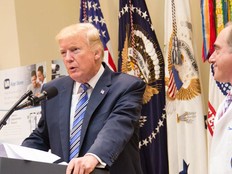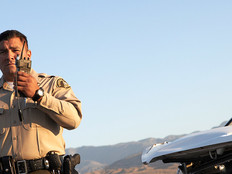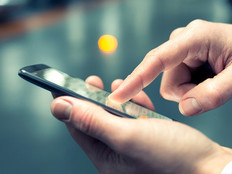How Augmented Reality Can Help Federal Agencies
In the future, a border agent may use computerized glasses to identify signs that a vehicle might be transporting drugs. By processing information about the vehicle — improperly inflated tires, for example, or an off-kilter grill — the glasses alert the agent that the vehicle should be inspected more closely.
“I think those kinds of things, you might be able to do fairly quickly” using augmented reality technology, says Mark Borkowski, assistant commissioner of the Office of Technology Innovation and Acquisition at U.S. Customs and Border Protection.
Augmented reality, which involves overlaying graphics and other information onto images of the real world, could help agencies in a variety of tasks, but for now, it’s in limited government use. Several agencies are looking into how AR can help them accomplish their missions more effectively.
For example, NASA has developed its Spacecraft 3D app, a program that lets public users see three-dimensional images of its various spacecraft when they point a smartphone or tablet at a printed AR target. The app is available for both iOS and Android devices.
“You can walk around the table, and you see all sides of the object,” says Kevin Hussey, manager of visualization technology applications and development at NASA’s Jet Propulsion Laboratory. “It really is like a 3D object sitting there.”
By 2017, more than
2.5 billion
downloads of augmented reality apps will be made annually to smartphones and tablets.
SOURCE: “Mobile Augmented Reality: Entertainment, LBS and Retail Strategies 2012–2017 (Juniper Research, November 2012)
It’s a fun, educational use of augmented reality, but Hussey envisions applying the technology to more practical purposes, such as spacecraft assembly.
“Imagine you’ve got a Curiosity rover, with wiring harnesses that are pretty complicated,” he says. “Imagine having an augmented reality program, where you could shine your tablet on the side of the rover, and it would show you where on the rover they go, and where to put the cables so they don’t get pinched.”
“If they wanted us to do this, it could be ready to roll in a year,” he adds.
Brainstorming Potential Uses for Augmented Reality
In a study released this year by Deloitte’s GovLab think tank, the authors imagined potential government uses for augmented reality, ranging from training border agents to spotting potential terrorists to assisting with storm rescues.
One scenario describes a warning message that appears in a Transportation Security Administration officer’s field of vision when an unidentified man at an airport paces anxiously around the back of a car, and then the man is tagged with a yellow hue and tracked throughout the airport.
Blair MacIntyre, an associate professor in the School of Interactive Computing at Georgia Tech, says such uses are still futuristic, but simpler applications could be developed relatively quickly. For example, he calls the idea of using augmented reality to assist with spacecraft assembly “doable” and says that using the technology to identify travelers in isolation — rather than picking them out of a crowd and tracking them — sounds “more reasonable.”








